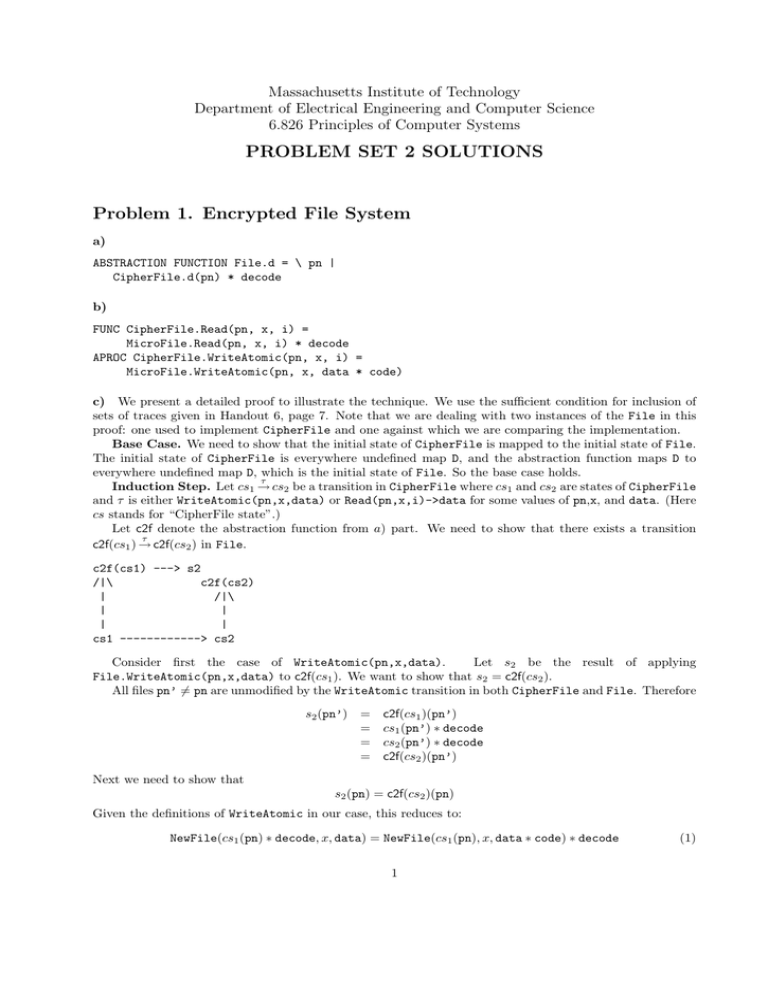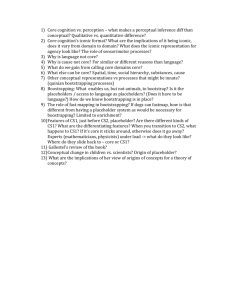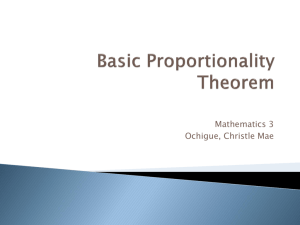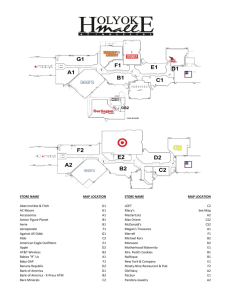Document 13548602
advertisement

Massachusetts Institute of Technology
Department of Electrical Engineering and Computer Science
6.826 Principles of Computer Systems
PROBLEM SET 2 SOLUTIONS
Problem 1. Encrypted File System
a)
ABSTRACTION FUNCTION File.d = \ pn |
CipherFile.d(pn) * decode
b)
FUNC CipherFile.Read(pn, x, i) =
MicroFile.Read(pn, x, i) * decode
APROC CipherFile.WriteAtomic(pn, x, i) =
MicroFile.WriteAtomic(pn, x, data * code)
c) We present a detailed proof to illustrate the technique. We use the sufficient condition for inclusion of
sets of traces given in Handout 6, page 7. Note that we are dealing with two instances of the File in this
proof: one used to implement CipherFile and one against which we are comparing the implementation.
Base Case. We need to show that the initial state of CipherFile is mapped to the initial state of File.
The initial state of CipherFile is everywhere undefined map D, and the abstraction function maps D to
everywhere undefined map D, which is the initial state of File. So the base case holds.
τ
Induction Step. Let cs1 → cs2 be a transition in CipherFile where cs1 and cs2 are states of CipherFile
and τ is either WriteAtomic(pn,x,data) or Read(pn,x,i)->data for some values of pn,x, and data. (Here
cs stands for “CipherFile state”.)
Let c2f denote the abstraction function from a) part. We need to show that there exists a transition
τ
c2f(cs1 ) → c2f(cs2 ) in File.
c2f(cs1) ---> s2
/|\
c2f(cs2)
|
/|\
|
|
|
|
cs1 ------------> cs2
Consider first the case of WriteAtomic(pn,x,data).
Let s2 be the result of applying
File.WriteAtomic(pn,x,data) to c2f(cs1 ). We want to show that s2 = c2f(cs2 ).
All files pn’ �= pn are unmodified by the WriteAtomic transition in both CipherFile and File. Therefore
s2 (pn’) =
=
=
=
c2f(cs1 )(pn’)
cs1 (pn’) ∗ decode
cs2 (pn’) ∗ decode
c2f(cs2 )(pn’)
Next we need to show that
s2 (pn) = c2f(cs2 )(pn)
Given the definitions of WriteAtomic in our case, this reduces to:
NewFile(cs1 (pn) ∗ decode, x, data) = NewFile(cs1 (pn), x, data ∗ code) ∗ decode
1
(1)
This means that the sequences need to be equal at every index i. Consider the structure of NewFile.
Assuming that the write does not start after the end of file, we have that NewFile either retains the original
value or replaces it with the value of argument. If the original value is preserved, then the i-th element in
the sequence on both sides is decode(cs1 (pn)(i)). If the value is overwritten, then the i-th element in the
sequence on left hand side is
decode(code(data(i − x)))
and the element on the right hand side is data(i-x), which is equal because decode and code are inverse
functions. Here x is the length of the pn files. (CypherFile and File have equal lengths, by the abstraction
function.)
Note. We used the assumption that there are no writes that start past the end of the file. Without that
assumption, the left hand side would evaluate to 0 and the right hand side to code(0) so the abstraction
function would not work.
Next we consider the case of Read(pn,x,i)->data in CipherFile. Because Read is a function, it does
not modify the state. This means that cs2 = cs1 . All we need to show is that we can apply a transition
Read(pn,x,i)->data in File i.e. that the results of two function calls are the same. The transition in File
does not modify the state either so the two states resulting from transition will be clearly related by c2f.
To show that the two results of Read(pn,x,i) are the same, we use the definition of Read operation in
CipherFile and File:
CipherFile.Read(pn,x,i) = cs1 (pn).seg(x,i) ∗ decode
= (cs1 (pn) ∗ decode).seg(x,i)
= c2f(cs1 ).seg(x,i)
= File.Read(pn,x,i)
d) Yes, File implements CypherFile as far as Read and WriteAtomic operations are considered. It is
sufficient to use the following abstraction function.
ABSTRACTION FUNCTION CypherFile.d = \ pn |
File.d(pn) * code
The proof that implementation meets the specification is analogous to the c) part.
Problem 2. Run-length Encoding File System
a)
FUNC expand(p: Pair) -> SEQ Byte =
VAR b : Byte, n: Int | (b,n) = p =>
VAR s : SEQ Byte | s.size = n /\ ALL i: IN 0..n-1 | s(i)=b =>
RET s
FUNC expandAll(data: SEQ Byte) -> SEQ Byte =
+ : (data * expand)
ABSTRACTION FUNCTION MicroFile.d = CompressFile.d * expandAll
b)
TYPE CompData = SEQ Pair SUCHTHAT (\s |
ALL i: 0 .. s.size-2 | ~(fst(s(i))=fst(s(i+1)))
2
c)
The following implementation avoids expanding part of the file that is skipped while reading.
FUNC DataRead(cd: CompData, i: Nat) -> Data =
VAR b: Byte, n: Int | (b,n) = cd.head =>
IF (i >= n) => RET expand(b,n) + DataRead(cd.tail, i-n)
[*] RET expand(b,i)
FUNC DataSeek(cd: CompData, x: Nat, i: Nat) -> Data =
VAR b: Byte, n: Int | (b,n) = cd.head =>
IF (x >= n) => RET DataSeek(cd.tail, x-n, i)
[*] RET DataRead({(b,n-x)} + cd.tail, i-x)
FI
FUNC Read(pn: PN, x: Nat, i: Nat) -> Data =
DataSeek(d(pn),x,i)
APROC fix(cd: CompData) -> CompData = <<
VAR cdPre: CompData,
b: Byte, n1: PosInt, n2: PosInt |
cd = cdPre + { <0, <b,n1>>, <1, <b,n2>> } =>
RET cdPre + { <0, <b,n1+n2>> }
[*] RET cd >>
APROC Append(pn: PN, b: Byte) = <<
d(pn) := fix(d(pn) + { <b,1> }) >>
d) No. Provided that the invariant in b) holds, the abstraction function is a bijection between the two
spaces. This means that there is exactly one CompressFile.d value for each MicroFile.d value.
e) The base case is easy because both systems start with en empty file. The inductive case needs to show
the correctness of Append and Read implementations.
Note. As in the formulation of the problem set formulation we use notation x to denote a list of length
1. This is just a shorthand that means <0,x> namely a seqence (function) that maps 0 to x and is undefined
everywhere else.
Append specification adds a byte to the end of the file. Append implementation first adds a pair of byte
and number 1 to the end of the file, and then calls fix. The correctness of the implementation follows from:
expandAll(cd + { <b,1> }) = expandAll(cd) + { b }
and
expandAll(fix(cd)) = expandAll(cd)
The last equation holds because
expandAll(cdPre + { <0, <b,n1>>, <1, <b,n2>> })
= expandAll(cdPre) + expandAll({<b,n1>}) + expandAll({<b,n2>})
= expandAll(cdPre) + expandAll({<b,n1+n2>})
= expandAll(cdPre + {<b,n1+n2>})
To show the correctness of Read, we show that
DataSeek(cd,x,i) = expandAll(cd).seg(x,i)
DataRead(cd,i) = expandAll(cd).seg(0,i)
The proof is by induction which corresponds to the recursive definitions of DataSeek and DataRead. (This
induction is well founded because the length of data decreases in each recursive call.)
3
Correctness of DataRead.
If i < n then
The recursion terminates always on a list cd of length at least one.
DataRead({<b,n>}+cd,i) = expand(b,i) = expand(b,n).seg(0,i)
= expandAll({<b,n>}+cd).seg(0,i)
If i ≥ n then
DataRead({<b,n>}+cd,i) = expand(b,n) + DataRead(cd,i-n)
= expand(b,n) + expandAll(cd).seg(i-n)
= expandAll({<b,n>} + cd).seg(0,i)
Correctness of DataSeek.
If x < n then
The recursion again terminates always on a list cd of length at least one.
DataSeek({<b,n>}+cd,x,i) = DataRead({<b,n-x>}+cd, i-x)
= expandAll({<b,n-x>}+cd).seg(0,i-x)
= expandAll({<b,x>}+{<b,n-x>}+cd).seg(x,i)
= expandAll({<b,n>}+cd).seg(x,i)
If x ≥ n then
DataSeek({<b,n>}+cd,x,i) = DataSeek(cd,x-n,i)
= expandAll(cd).seg(x-n,i)
= expandAll({<b,n>}+cd).seg(x,i)
Problem 3. Cache Replacement Policies
We first observe that the queue variable is not sufficient for maintaining the information on which block was
most recently used, because it only keeps track of the dirty blocks. (It’s purpose is to ensure that the writes
are performed in order.)
We therefore introduce another list usage which contains all valid blocks of the cache from the most
recently used to the least recently used. We define internal procedures cacheRead and cacheUpdate used
to read and write the cache. We then make these operations maintain the information on which block was
used most recently in the usage list.
VAR usage: SEQ DA;
INVARIANT Subset(usage.rng, cache.dom)
FUNC removeElem(da: DA, u: SEQ DA) =
IF u.size=0 => {}
[*] u.head=da => u.tail
[*] { u.head } + removeElem(da, u.tail)
FI
APROC use(da) = << usage := { da } + removeElem(da,usage); >>
APROC cacheRead(da) -> DB = <<
use(da);
RET cache(da) >>
APROC cacheUpdate(da, db) = <<
use(da);
cache(da) := db; >>
We replace all reads updates to cache in read and write operations in the BufferedDisk implementation
with the calls to cacheRead and cacheUpdate. We can now define MakeCacheSpace that implements the
desired policies.
4
a)
LRU
FUNC nowFree() -> Int = cacheSize - cache.dom.size
APROC evict(da: DA) = <<
DO VAR i: Int | queue(i)=da => FlushQueue(i) OD;
cache(da) := undefined >>
APROC evictLRU() = << evict(usage.last); usage := usage.reml >>
PROC MakeCacheSpace(i: Int) -> Int =
VAR canGet: Int := min(cacheSize, i) |
DO << (nowFree() < canGet) => evictLRU() >> OD
RET canGet
b)
LRUCF
FUNC removeith(i: Int, s: SEQ DA) =
s.seg(0,i-1) + s.seg(i+1,s.size-1)
APROC evictLRUCF() = <<
VAR usageClean: SEQ DA :=
{ j :IN usage.dom | clean(usage(j)) } |
IF usageClean.size=0 => evict(usage.last); usage := usage.reml
[*] evict(usage(usageClean.last));
usage := removeith(usageClean.last, usage)
FI >>
PROC MakeCacheSpace(i: Int) -> Int =
VAR canGet: Int := min(cacheSize, i) |
DO << (nowFree() < canGet) => evictLRUCF() >> OD
RET canGet
The correctness of the implementation follows from the fact that cacheRead and cacheUpdate peform
the same actions on the cache and return the same results as the read and update operations on cache.
MakeCacheSpace evicts blocks from the cache, but does so only through evict procedure, which in turn uses
FlushQueue. This ensures that block is written back before being evicted, and it ensures that the order of
writes is preserved because it is always an entire prefix of the queue that is written back.
5







